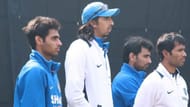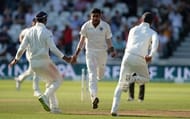
Exactly four years ago in 2015, Virat Kohli had taken over from MS Dhoni as the full-time Test captain and India had conceded the Border-Gavaskar Trophy to Australia. The questions around the fast bowling prospects posed to the new captain during the post-match press conference didn't seem to stop. Kohli being the outspoken captain, cited the example of Josh Hazelwood and felt fitness and intensity separated the two fast-bowling groups.
The legendary Anil Kumble and Kohli brought Shankar Basu, the eminent fitness trainer on board. The next task was to identify who would form the core group of fast bowling.
The fast bowlers had put on the hard work regarding fitness and strength training, and they were a yard quicker. Once they went to the West Indies tour in 2016, Indian Test unit looked quite promising.
Let's look into some of the reasons that transformed the Indian Fast bowling unit.
#1 Showing more confidence in the ability

When MS Dhoni was the leader from 2008 to 2014, he somehow preferred to control the game with spinners. The fast bowlers would play a supporting role in home conditions as spinners would do the job for the side.
After the initial burst with the new ball in overseas conditions, MSD would often be forced to set defensive run-saving fields, and the game would meander away from India. This would transfer the pressure on the batsmen who were expected to score big against quality fast-bowling attacks away from home.
However, with Virat Kohli, the same set of bowlers have looked more lethal because the captain has always shown a lot of faith in them. Irrespective of the conditions, Kohli has preferred using his fast bowlers in short bursts and looked for wickets.
When England and Australia toured India in 2016/17, it was not just about the spinners running riot, but the role of the fast bowlers who provided early breakthroughs by consistently bowling at speeds near about 90 mph.
Even when things have not gone their way initially, he has shown confidence, and they have come back and delivered in their next spells. The best examples have been Jasprit Bumrah and Mohammed Shami in South Africa and Australia where they razed out the batsmen in a single spell.
#2 Finding the right man for the right job

Whenever India has played on overseas shores, India would rely on one or two bowlers to deliver the killer blow to the opposition. We remember Ajit Agarkar and Sreesanth having dream spells in Australia and South Africa respectively. However, due to the lack of consistency, they would find it difficult to get going in different conditions where there was too much swing or the lack of it.
With Virat Kohli at the helm, who loves and understands fast-bowling, India has become better in understanding who can deliver in what conditions.
Bhuvneshwar Kumar is one of the best swing bowlers if there is lateral movement. There is Ishant Sharma who can hit the pitch hard and generate steep movement. Mohammed Shami is adept in bowling back of a length and very skillful with the old ball if there is reverse swing on offer. We have the magician Jasprit Bumrah who can change lengths at will and has great variations. Umesh Yadav is easily the quickest and bowls hard lengths. Hardik Pandya is quite a handful as a fourth seamer and is usually accurate with his lengths.
This pretty much covers all bases which have become one of the main reasons why India has bowled so well on different pitches and different conditions overseas.
#3 Looking for wickets in all conditions

In India's last overseas leg in 2013/14, India failed in bowling out oppositions and squandered match-winning opportunities. Once the batsmen got going, India would start saving runs. This resulted in batsmen scoring aplenty, and the games would slip away from Day 1 itself.
India would prefer to play the waiting game and allow the opposition captain to make a declaration. India would already have their backs to the wall due to mounting scoreboard pressure.
Kumble and Kohli advocated the fact about getting 20 wickets in a test match every single time. When India started their overseas tours, it was evident that they were looking for wickets all the time. When AB De Villiers was running riot in Cape Town or Jos Buttler, and Ben Stokes had a 150-run partnership in Trent Bridge, India did not lose patience and tried picking wickets.
Due to this change in mindset, one resulted in two, and two resulted in a batting collapse. If we look at India's four wins in 2018 or the ones where they competed so well, it was all due to the relentless bowling which resulted in batting collapses.
If we look at the wickets taken by the quicks this year outside the sub-continent, they have outbowled every other nation with 151 wickets shared between the six quicks in 14 test matches in 2018.
#4 Making the bowlers bowl longer spells

Indian spinners Ravichandran Ashwin and Ravindra Jadeja are pinpoint accurate for a reason, they bowl a lot of overs which will help them work out the lengths to bowl. However, fast-bowlers would not have the miles in their legs and wilt under the pressure of the opposition batsmen in conditions which would suit fast-bowling.
Kumble and Kohli made a conscious effort to make the fast bowlers bowl a lot of overs even in the hot scorching sun. They would bowl a few overs with the new ball and rotate around and come back again after lunch and tea. They would build the pressure and spinners would benefit out of this. Since they were used in short bursts, they had the energy and strength to bowl four or five hostile spells in a day.
Since January 5, the first day of the Cape Town Test to December 30, Shami has bowled a total of 383.5 overs, Bumrah has bowled 379.4 overs, Ishant has bowled 335 overs. Umesh and Hardik have bowled 126.5 and 124 overs respectively.
India could even afford to drop Bhuvneshwar Kumar, a 21-Test veteran and a strike bowler in Australia as they had others who were more suitable and match-fit than him to do the job.
#5 Developing a variety of bowlers

India can boast of having a wide variety of bowling options when it comes to pace and spin. England becomes toothless in conditions which don't aid swing. South Africa and New Zealand have always struggled in the sub-continent. Australia has great bowlers, but they lack a smart second spinner who can do the trick for them in Asian conditions.
Similarly, the Asian teams Sri Lanka and Bangladesh have excellent spinners who become ineffective once they travel to pace friendly countries. Pakistan has promising bowlers and a great leg-spinner in their ranks but somehow lack the consistency to deliver.
India, on the other hand, has developed a good pool of fast bowlers and spinners. There is Ishant Sharma, a 90-Test veteran, who seems keen on leading the attack. Bhuvneshwar, Shami, Bumrah, Umesh, Shardul, and Hardik have different skill-sets.
India also has Khaleel Ahmed, Deepak Chahar and Siddharth Kaul who serve as back up options. Similarly, the U-19 team has some serious talent with the likes of Shivam Mavi, Kamlesh Nagarkoti and Ishan Porel capable of bowling close to 150 kph consistently.
Follow IPL Auction 2025 Live Updates, News & Biddings at Sportskeeda. Get the fastest updates on Mega-Auction and cricket news
